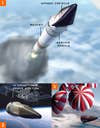Back to the Future
NASA: Space-plane bidder puts winglets on vintage capsule design.

by Courtesy Lockheed Martin, background images courtesy Earth Sciences and Images Analysis Laboratory, NASA Johnson Space Center
Lockheed Martin’s “lifting capsule” should be small and light enough for a medium-lift rocket to launch without extra side-mounted boosters (1). An attached service module, equipped with fuel and small rocket thrusters, will maneuver the four-person space plane for docking to the space station (2). With a bigger service module, the winged capsule could be used for longer missions, such as delivering crew to a future Mars or Moon craft. The capsule’s flat bottom will give it a better glide range than an Apollo-type cone, but the small wings will not be big enough for a runway landing, so the final recovery will use parachutes (3).
Retro tech is in fashion at NASA. As Congress and the White House debate the agency’s future, NASA is pushing its big contractors to build a new “space taxi” as soon as possible, to get astronauts to and from the International Space Station more safely than the shuttle does.
“Safe,” “soon” and “simple” are the watchwords, according to Mike Coats, the former shuttle pilot who leads the Lockheed Martin team competing to build the orbital space plane (OSP). NASA is expected to choose between Boeing and Lockheed Martin (which is working with Northrop Grumman and Orbital Sciences) this summer.
Don’t expect to see OSP emerge as the “mini-shuttle” —
a reusable craft that lands like an airplane — envisaged before the Columbia accident, says Coats. NASA’s astronaut community is leaning toward a simple cone- or sphere-shaped capsule, like the Apollo or Russia’s Soyuz. It’s seen as the safest solution and the most likely to be ready by 2008, when NASA wants the OSP to be in service as a lifeboat for the space station.
But a winged spacecraft has its advantages, Coats says. NASA wants a vehicle that can get a sick astronaut to a U.S. hospital within 24 hours. Because a winged vehicle can glide when it hits the atmosphere, it doesn’t have to wait until the space station’s orbit takes it directly across the U.S. In the case of an aborted launch, the winged vehicle also has a better chance of finding a landing spot.
But a simple capsule is gaining favor, according to Coats, because it’s stable and forgiving when things run amok. In May, when U.S. astronauts rode a Soyuz down from the station, the capsule’s guidance system broke down. The Soyuz tumbled, putting the crew through loads equal to eight times the force of gravity, and landed about 300 miles off target, but what impressed NASA was that the crew survived a major failure. Another issue is the life span of the vehicle. A winged vehicle is too complex to be thrown away, but some at NASA like the idea of a one-shot or short-lived vehicle, says Coats, because it’s possible to incorporate improvements on the production line, rather than periodically grounding a mini-shuttle OSP for upgrades.
Boeing is still studying both
a capsule and a winged mini-shuttle and won’t say which it will finally offer to NASA. The Lockheed Martin team is looking at both a capsule and a hybrid design that it calls a lifting capsule (see graphic, left).
While Coats admits that capsules look old-fashioned, he argues that the mission is to get people into and out of orbit safely: “The sexy part of spaceflight ought to be what you do when you’re out there.”